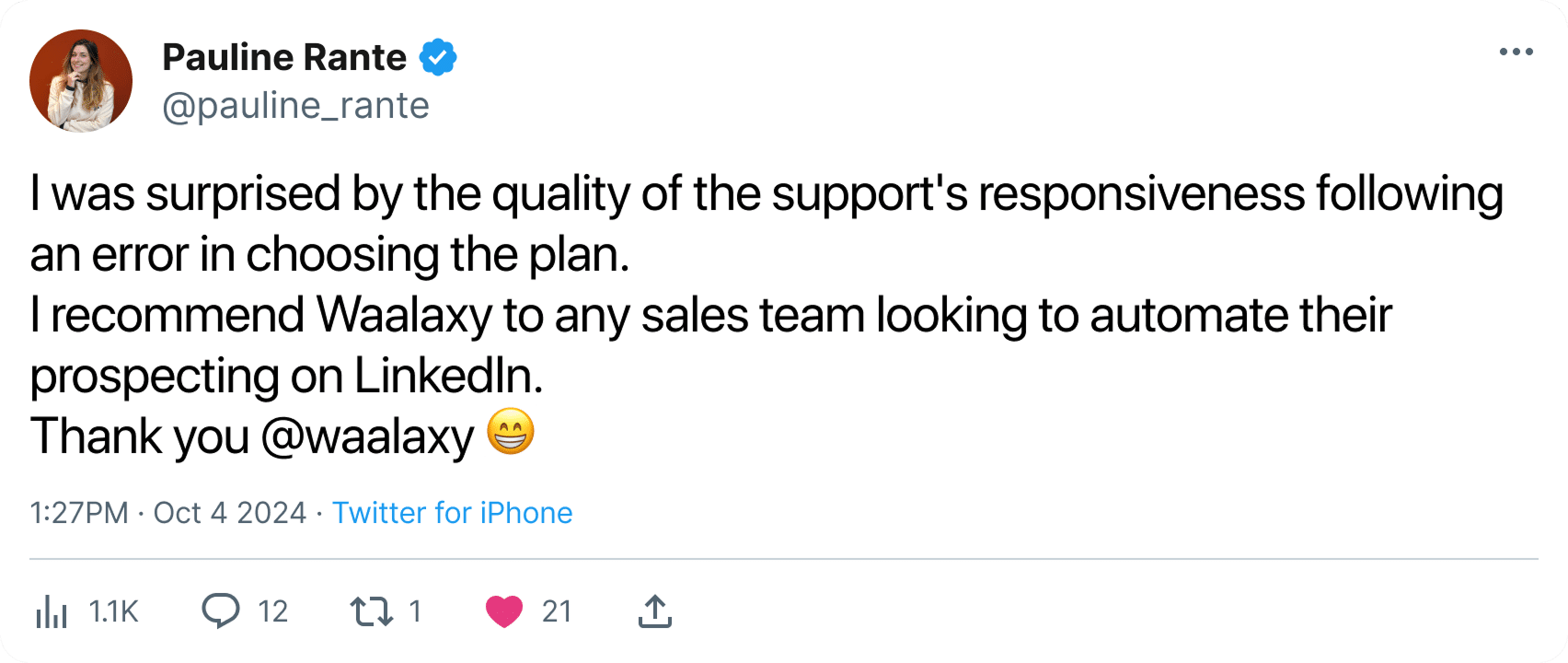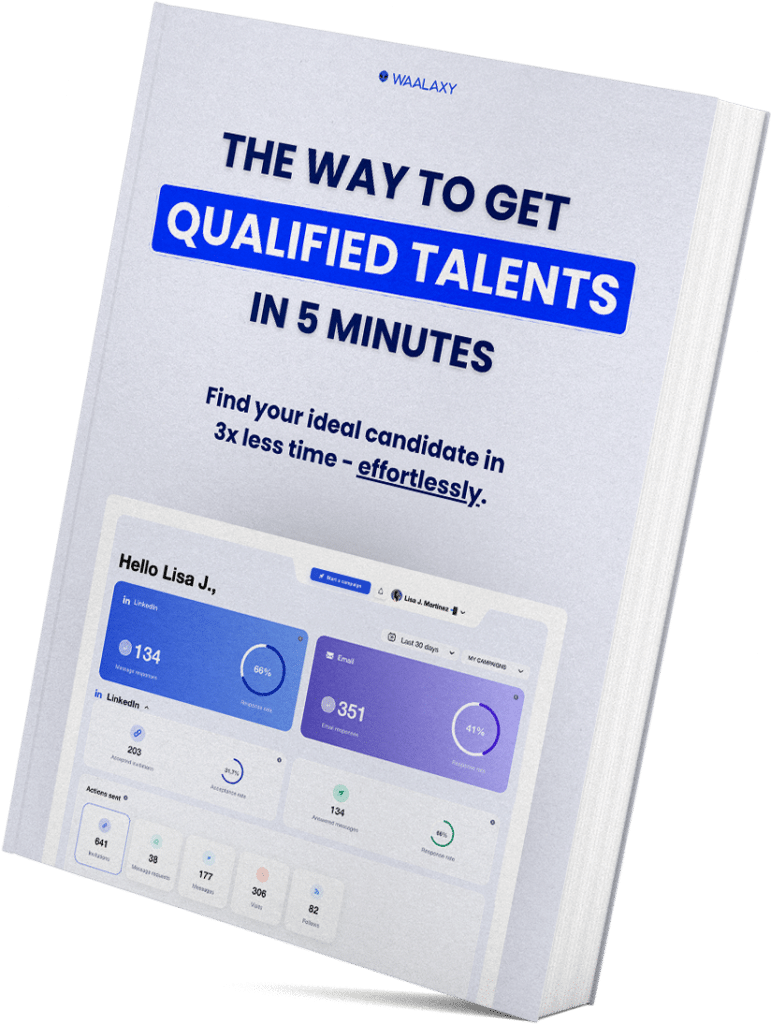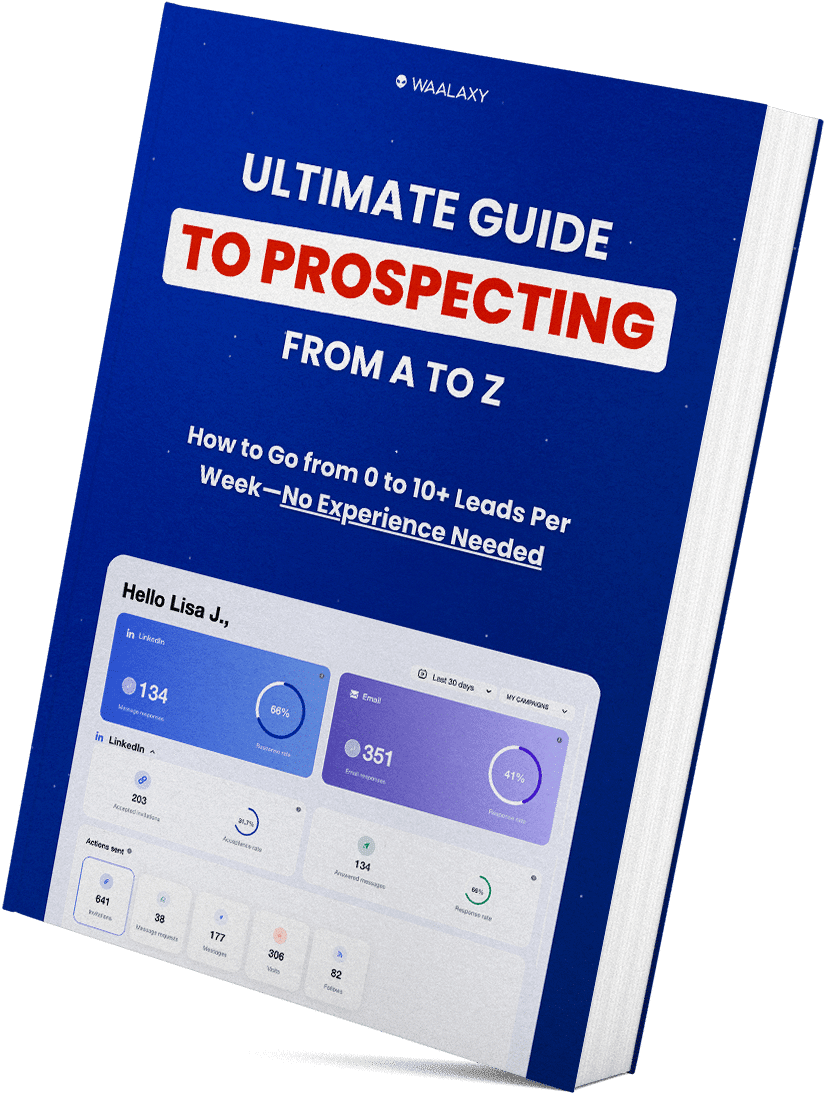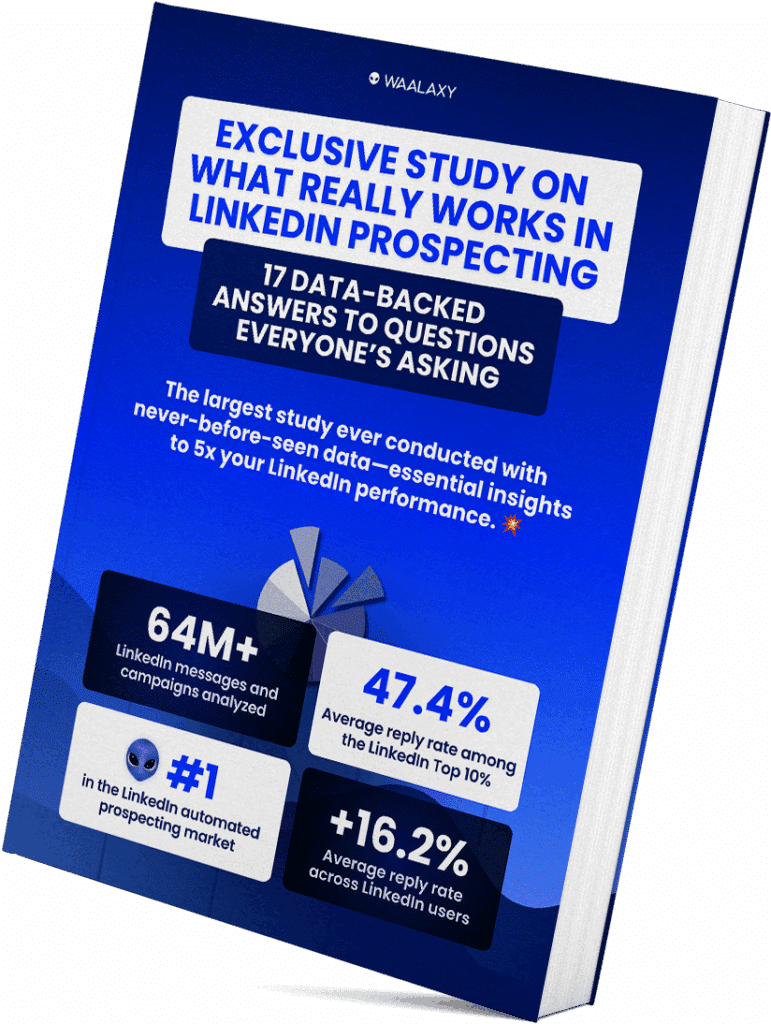LinkedIn KPIS are essential to know if your efforts are bearing fruit. You send connection requests, post regularly and engage in private message conversation
That’s all well and good, but how do you know if your actions on LinkedIn are really working? 👀
The answer lies in three letters: KPI.
Today, we’re going to share with you our 8 must-have LinkedIn KPIs to steer your prospecting like a boss (or rather, a pilot 😅).
Fasten your seatbelts, here we go! (Reading time: 3 minutes).
Why is it essential to follow KPIS on LinkedIn?
LinkedIn is much more than just a social network: it’s a platform of visibility and authority. At the same time, with over a billion users, you’ve got plenty of choice.
However, many users still simply publish or send messages without analyzing the results.
Difficult to identify what really works and what doesn’t.
Tracking KPIs allows you to:
- 🔵 Evaluate the effectiveness of your prospecting.
- 🔵 Optimize your messages and content.
- 🔵 Prioritize high-impact actions.
- 🔵 Identify the most effective conversion levers.
That’s why we’ve come up with 8 KPIs you need to know. 👇🏼
I. Visibility and commitment: the first indicators to track
Prospecting on LinkedIn isn’t just about volume. What really counts is the quality of the relationship you create. And that starts with the very first interaction. 💭
1) Acceptance rate of connection requests
This first key performance indicator enables you to assess the relevance of your approach and the quality of your profile. 😇
In fact, a low acceptance rate may be a sign that your messages are poorly targeted or not very engaging:
- Less than 20%: your approach needs to be optimized.
- The average acceptance rate without a personalized message is around 38%.
Okay, but how do you calculate it? 🤔
(Number of invitations accepted / Number of invitations sent) x 100.
To improve it, you can use its 3 points:
- 1️⃣ Look after your profile ⭢ professional photo, value-oriented summary.
- 2️⃣ Add (or not) a rating according to your strategy.
- 3️⃣ Follow up after 7 days if an invitation goes unanswered.
2) Response rate to private messages
Once the connection has been established, you need to engage in conversation. This KPI lets you know whether your private message worked or not. 👀
(Total number of replies received / Number of messages sent) x 100.
If you want to boost your response rate, start with : 👇🏼
- Ban commercial messages from the outset.
- Use open-ended questions or key data.
- Test different formulations to find the most effective.
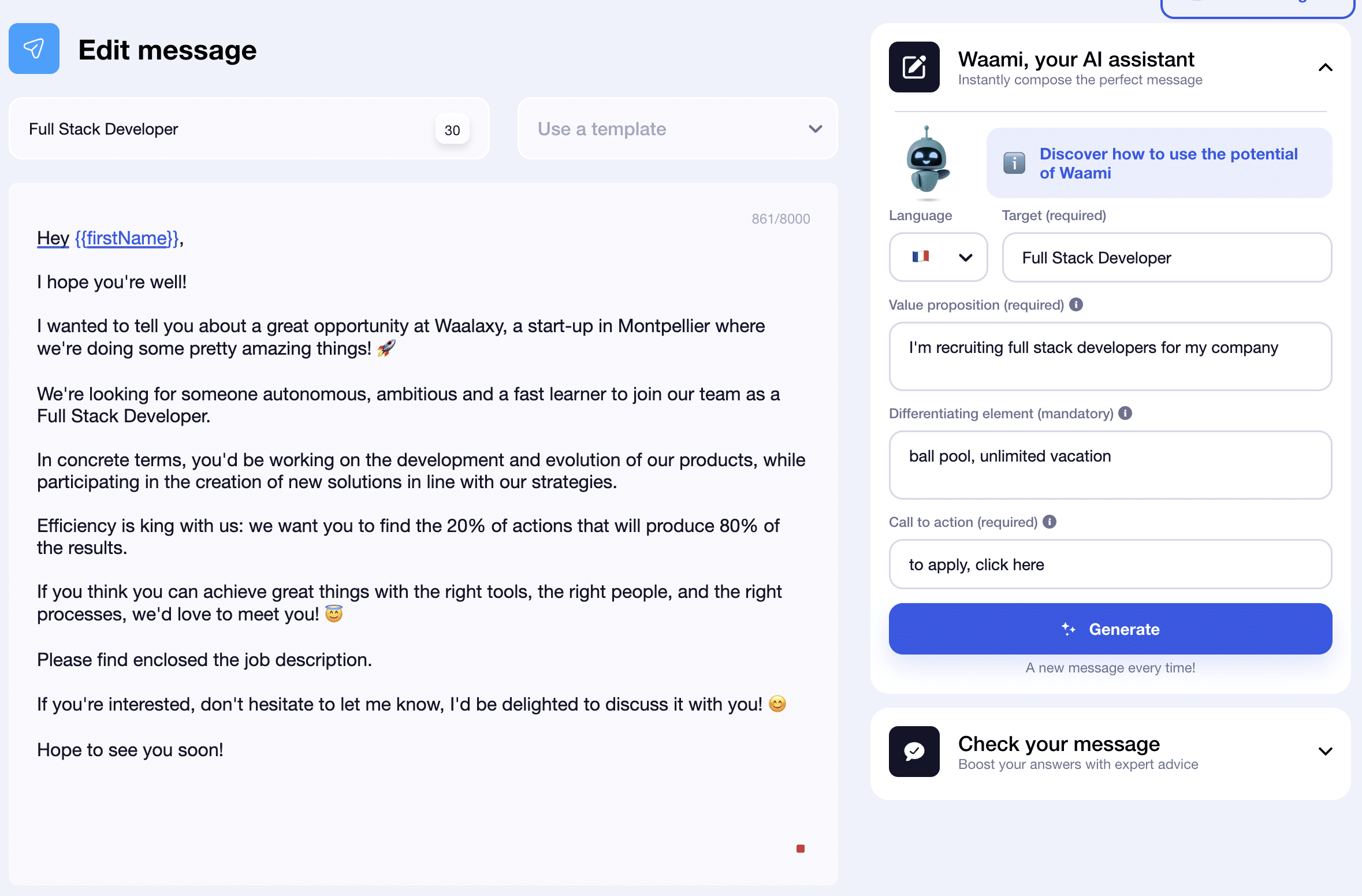
II. Authority and content: building your credibility
LinkedIn isn’t just a prospecting tool. It’s a personal medium, your online CV.
All your content is your showcase, so it needs to captivate your audience. 🔥
3) Rate of engagement on your publications
As the name suggests, this KPI reflects your audience’s interest in your content, namely likes, comments and shares. 💬
To calculate it: (Total interactions / Number of views) x 100.
For example, if you have 2,000 interactions for 50,000 views, you’ll have 4% engagement (above the French average of 3.24%). 📊
If you want to improve, you can: ⬇️
- Write catchy hooks.
- End your posts with an open-ended question.
- Air out your texts with line breaks and integrate visuals or emojis.
4) Reach of your publications
Nothing too complicated, but just as important: the number of people who see your content.
There’s no formula here, just 2 elements to keep an eye on:
- 1️⃣ Ratio between impressions and number of connections.
- 2️⃣ Relevance of audience reached.
If you want to optimize the reach of your publications, you can :
- Publish at strategic times.
- Reformulate and republish your best posts in other formats (video, carousel, etc.).
5) Click-through rate (CTR) on shared links
It’s often overlooked, but don’t underestimate it – it’s completely useful. If you’re sharing resources, the click-through rate shows you whether your audience stops at your post or clicks on your link.
Okay, but what’s the formula? 🤔
(Number of clicks / Number of views) x 100.
If you’d like to improve your click-through rate, simply :
- 🔵 Use clear, visible CTAs.
- 🔵 Incite curiosity.
- 🔵 Position your links in the right place in the post (often at the end or in the comment).
III. Conversion: the business impact of your prospecting
Visibility is good, but qualified leads, appointments and customers are even better.
6) LinkedIn KPI: Number of qualified leads
Start by defining what a qualified lead means to you (positive response, resource download, etc.).
Then you can use the following formula: (Number of qualified leads / Number of people contacted) x 100.
Tip for increasing this KPI:
- 🥇 Refine your targeting.
- 🥈 Personalize your messages.
- 🥉 Use resources that may be of interest to them.
7) Appointment booking rate
This KPI is simple: it measures the transition from an exchange to a meeting.
There are two possible formulas for this:
- On all messages: (RDV / Messages sent) x 100.
- On leads: (RDV / Qualified leads) x 100.
Okay, but how can we improve it? 🤔
First of all, don’t bring your pitch too early, or they’ll run away….
And above all, offer two slots so that the lead has a better chance of being available. 📅
8) Customer conversion rate
This is already the last KPI, and the most important in my eyes, the one that measures the impact on your sales!
Formula: (Number of customers / Number of leads generated) x 100.
To maximize your chances, be more precise in your targeting and add social proof to build trust.
How about a recap?
You may feel like you’re doing everything right. You’re posting regularly, sending messages and nurturing your network, but your strategy isn’t taking off.
But, when was the last time you looked at your KPIs? 👀
LinkedIn can be a powerful tool provided you know how to use it well.
LinkedIn’s best test, analyze and adjust their strategy. 📊
You can continue to act blind, or you can decide today, to run your strategy like a pro.
Here’s a quick rundown of LinkedIn KPIs and formulas. 👇🏼
| LinkedIn KPI | Usefulness | Calculation formula |
|---|---|---|
| Connection acceptance rate. | Measure whether your profile inspires confidence and your approach is relevant. | (Invitations accepted / Invitations sent) × 100. |
| Message response rate. | Evaluate prospects’ commitment to your approach. | (Replies received / Messages sent) × 100. |
| Rate of engagement on publications. | Measure interest in and interaction with your content. | (Likes + Comments + Shares) / Views × 100. |
| Reach of publications. | Evaluate the real visibility of your posts beyond your network. | Number of impressions (via LinkedIn). |
| Click-through rate (CTR). | Identify the effectiveness of your calls to action (links). | (Clicks on link / Views of post) × 100. |
| Number of qualified leads. | Quantify genuinely interested and relevant prospects. | (Qualified leads / People contacted) × 100. |
| Appointment rate. | Measure the transition from intention to actual exchange. | (Appointments made / Qualified leads or messages sent) × 100. |
| Customer conversion rate. | Evaluate how many prospects become customers. | (Customers obtained / Leads generated) × 100. |
Frequently asked questions
We end this article with 3 frequently asked questions. ⬇️
What are the KPI indicators?
KPIs (Key Performance Indicators) are indicators that enable you to measure the effectiveness of your prospecting and your presence on LinkedIn. Here are the most important ones to track: 👇🏼
- Connection acceptance rate: reflects the attractiveness of your profile and the relevance of your approach.
- Message response rate: measures your prospects’ interest in contacting you.
- Rate of engagement on your publications: indicates whether your content generates interaction.
- Reach of your publications: measures how many people have seen your posts.
- CTR (click-through rate): evaluates the effectiveness of your calls to action in your publications.
- Number of qualified leads: indicates how many contacts are genuinely interested in your offer.
- Appointment booking rate: measures the transition from contact to sales appointment.
- Customer conversion rate: the final KPI, assessing your return on investment.
What is a good CTR on LinkedIn?
CTR (Click-Through Rate) is the number of clicks on a link divided by the number of views.
It lets you know whether your content prompts people to take action (towards a site, form, content, etc.).
A good CTR on LinkedIn is between 1.5 and 3%, depending on the type of content.
What is a good impression rate on LinkedIn?
The impression rate measures the visibility of your publications. Unfortunately, LinkedIn doesn’t provide this rate as a percentage directly, but you can compare the number of impressions to your number of connections or subscribers.
If you’re reaching between 30% and 60% of your network, that’s great! 🎯
Repackage your best poss in other formats to multiply impressions (video, carousel, storytelling).
You know all about LinkedIn KPIS! 💫


